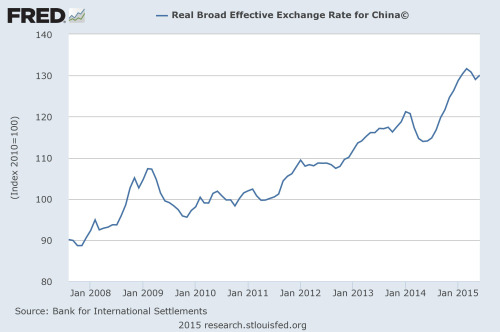China’s FX Paradigm Shift: What Are They Doing?
by Mark Dow, Behavioral Macro
The modern Chinese economic era really kicked off when it joined the WTO in 2001. This launched China’s integration into the global goods market.
It soon became a force. And the supporting exchange rate policy was simple: keep the currency weak—especially with respect to the dollar–in order to extend and protect China’s competitiveness advantage. Buy as many dollars as needed to make it happen. Invest the dollars into Treasuries.
By 2005-06 China seemed the dominant force in global trade and its exchange rate regime was receiving a lot of unwelcome political attention, most notably from Washington. Economists and politicians across the globe started to argue that China’s FX regime was fostering significant global imbalances, was not sustainable, and was not in China’s long-term interests.
Even though these pleas did not change China’s mercantilist mindset—after all, why change when times are good—China did cede to the political pressure and allowed CNY to begin to appreciate against the dollar.
But the change of heart didn’t come until later. In the global financial crisis of 2008-09, China saw the US wobble, Europe stumble, and Japan lie there without a pulse. Suddenly, for the first time in a long while, China felt vulnerable. With its major export destinations under enormous demand pressure, China was forced to face up to rebalancing.
In that connection, China did two things: launch massive credit stimulus and, starting around 2010, alter its exchange rate regime.
Instead of trying to keep the currency artificially deprecated, the new policy was to allow FX appreciation in order to support consumption, the new growth engine. This policy would also facilitate rebalancing and to put reform pressure on the Export Machine, in the hopes of catalyzing faster productivity gains for the overall economy.
And what an appreciation it was. From 2010 until last week, CNY appreciated some 13% against the USD, while, in turn, the USD appreciated 20% against the euro and over 30% against the yen. The real broad effective exchange rate for China appreciated more than 30% over this period.
But that’s not the whole story. The total effective loss of competitiveness was considerably more. Wage gains in China in this same period were outstripping inflation by 8-10% a year. Even if you generously adjust for productivity gains and modest foreign wage rises, you end up with an annual ‘loss of competitiveness’ of at least 8-10%. Compound that.
All in, this is a meaningful move—even when taking into account China’s depreciated starting point. And it’s a move China would have never allowed if they were still perusing the mercantilist exchange rate policy of the earlier years.
So, is China’s currency now overvalued? Probably, but hard to say how much. China’s current account is still in surplus (see below)—and this in the face of weak partner country demand. (Then again, it is tough to know how much moderate over/undervaluation matters in a country where the import content in exports might still be as high as 50%.)
On the other hand, the capital account has had outflows, as many Chinese have been buying assets abroad. It is hard to say how much of this is a desire to protect wealth and how much is FX-induced attractive pricing. Nonetheless, these capital account outflows have been behind the BOP pressures that led to the reserve requirement rate (RRR) cuts, and, to some degree, last week’s decision to end the policy of selling dollars to keep CNY strategically stronger than it otherwise would be.
China seems to have decided that running your exchange rate too hot or too cold can have undesirable consequences. It’s no longer about poaching exports or stimulating consumption; it’s more about letting the exchange rate help the economy find balance in a complicated world. Moreover, if in adopting a more balanced and market-based FX regime China can gain economic stature and enhance prospects of becoming a reserve currency, in China’s eyes, all the better.
This doesn’t mean that the PBOC is done intervening. They most certainly will want to ensure an orderly FX market without excessive volatility. But it does suggest they have made a quantum leap away from using the FX regime heavy-handedly to engineer outcomes. This, to me, seems like a positive development for China—despite its secular growth problem—as well as a positive one for the world. Something free marketers should welcome. This is an emerging market devaluation that has reduced global risks, not increased them. Nor has it presaged, IMO, a return of the contagion-driven emerging market crises of yesteryear.
Copyright © Mark Dow, Behavioral Macro















